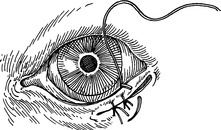Chapter 132 Diseases of the Eyelid
Diseases of the eyelid result in a variety of clinical signs. Initially, the eyelids alone may be affected, but because of their close proximity to the cornea and conjunctiva, disease of these structures frequently results. Because corneal and conjunctival involvement is often more severe and more obvious, eyelid disease may be overlooked. Manage concurrent conjunctival and corneal disease as described in Chapters 133 and 134, respectively, in this section.
Diseases of the eyelid can be broadly categorized by their appropriate treatment (i.e., surgery or medical therapy), as listed in Table 132-1.
Table 132-1 CLASSIFICATION OF EYELID DISEASES ACCORDING TO TYPE OF THERAPY
| Surgery | Medical Treatment |
|---|---|
| Ankyloblepharon | Bacterial blepharitis |
| Coloboma | Chalazion/hordeolum |
| Entropion | Allergic blepharitis |
| Ectropion | Parasitic and fungal blepharitis |
| Distichiasis/ectopic cilia | |
| Lagophthalmos | |
| Neoplasia |
ANATOMY
PRINCIPLES OF EYELID SURGERY
ANKYLOBLEPHARON
Ankyloblepharon is a condition seen in neonatal puppies in which the eyelids do not open properly.
COLOBOMA
ENTROPION
Classification
Anatomic Entropion
Anatomic Entropion with Secondary Spasm
Surgical Techniques
Ventral or Dorsal Eyelid Entropion
Lateral Entropion
Stay updated, free articles. Join our Telegram channel

Full access? Get Clinical Tree



